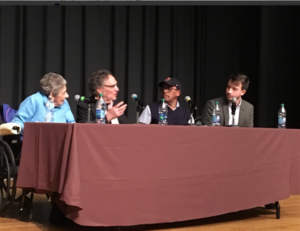This May, Kerry James Marshall’s painting Past Times sold for more than $21 million, making it the most expensive artwork sold by a living African American artist. Marshall is known for his various works in different media (painting, collage, video, etc.) that portray and comment on the history of black identity in the United States and in Western artwork. Marshall was born in Birmingham, Alabama and grew up in Watts, Los Angeles when the acknowledgment of pervasive discrimination against African Americans and other minorities was growing, and the civil-rights battle in America was beginning to reach its peak.
Past Times depicts a pastoral scene with black figures picnicking, listening to music, and engaging in other leisure activities in a park setting. It is in conversation with George Seurat’s famous “A Sunday on La Grande Jatte” which hangs in the Art Institute of Chicago. After a day of mystery following the record setting purchase, it was revealed by Marshall’s gallerist that the buyer was hip hop producer and entrepreneur, Sean “Diddy” Combs.
The video below documents a young Kerry James Marshall being interviewed by Jerry Blumenthal and Gordon Quinn about the African American experience and showing the pieces he was creating for the 1994 exhibition Chicago Crossings: Bridges and Boundaries at the Spertus Institute. The footage is part of a collection of 100 hours of footage shot by Kartemquin Films documenting the creation of the exhibition and the public response.
Chicago Crossings: Bridges and Boundaries

L-R: Gerda Meyer-Bernstein, Gordon Quinn, Othello Anderson, and Harrison Sherrod at the Chicago Cultural Center, May 16, 2018
The screening and discussion of Chicago Crossings: Bridges and Boundaries at the Chicago Cultural Center was an engaging and insightful opportunity to think about race in America and the role of art/artists. We were especially honored by the presence of Gerda Meyer Bernstein, who escaped Germany in 1939 and is still vibrant at age 94!
You can watch Kartemquin’s original video that accompanied the 1994 exhibition at the Spertus Institute here. We also screened this demo video reflecting on the aftermath of the exhibition, in a newly restored version.

0 Comments
You can be the first one to leave a comment.